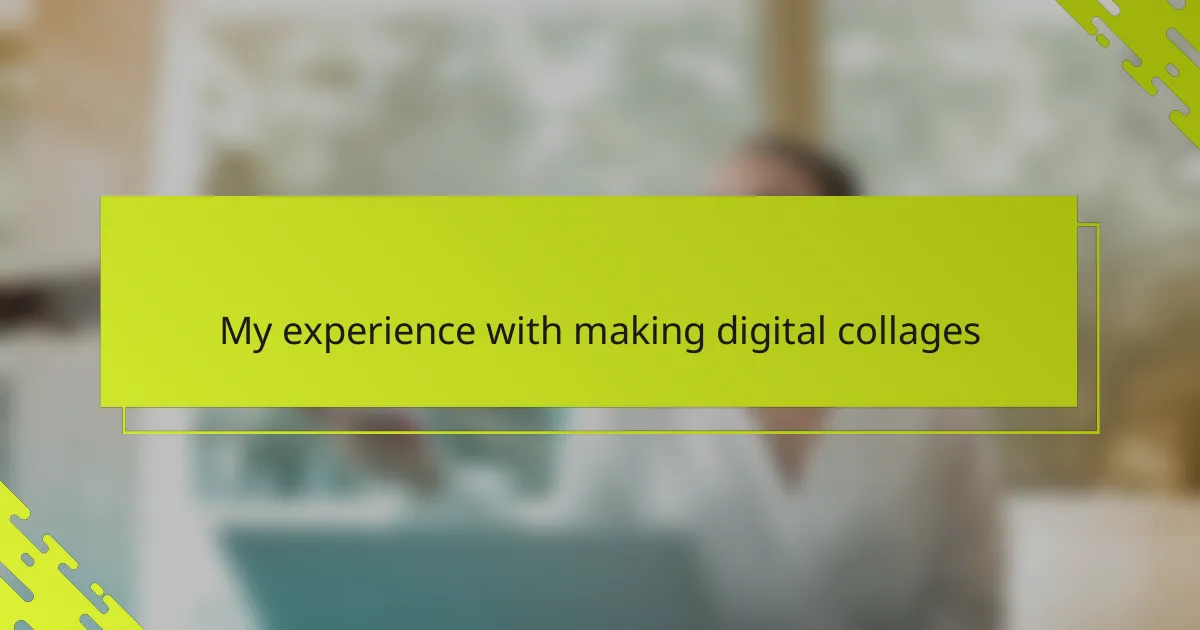Key takeaways
- Digital collages serve as emotional archives and visual dialogues that reflect the complexities of identity within queer women culture.
- Experimentation with tools and materials is essential, as combining digital and analog elements enhances storytelling and personal expression.
- Creating collages involves balancing visibility and nuance, ensuring diverse representations without succumbing to stereotypes.
- Sharing artwork transforms individual expression into collective experiences, fostering community dialogue and activism around queer resilience.
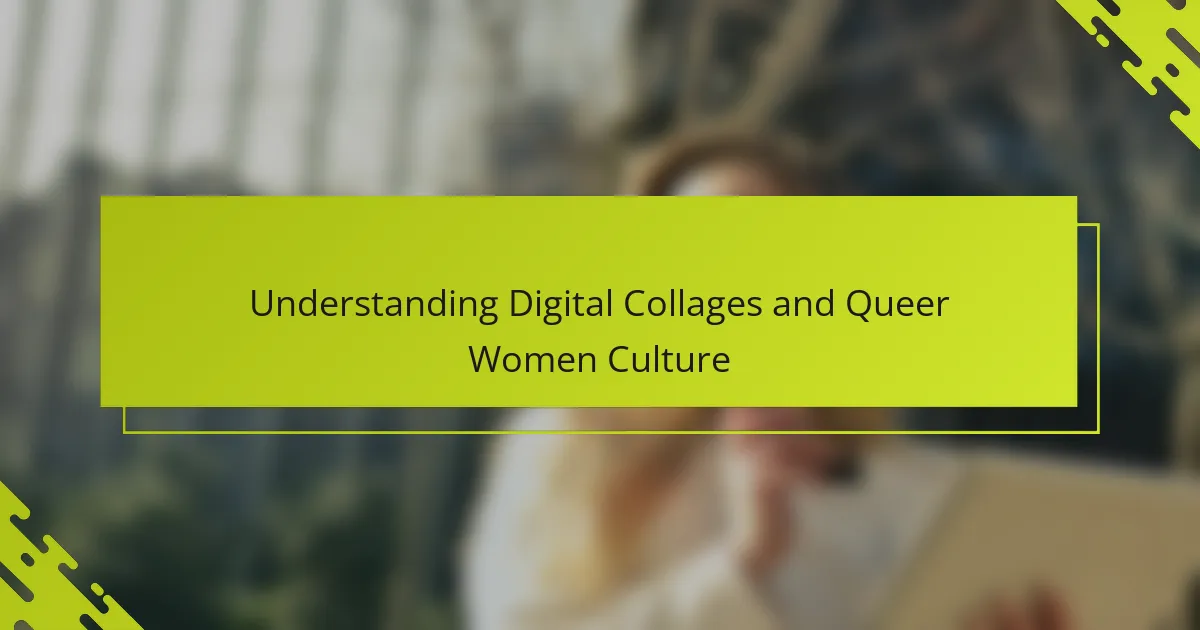
Understanding Digital Collages and Queer Women Culture
Digital collages have always felt like a perfect medium for me to explore and express the complexities of queer women culture. They allow me to layer images, texts, and symbols in ways that reflect the multifaceted nature of identity and community—a visual dialogue that feels authentic and raw. Have you ever noticed how combining unexpected elements in a collage can mirror the unexpected paths of self-discovery?
What strikes me most about creating these collages is how they capture more than just aesthetic value; they become emotional archives for the queer experience. Each pixel, each fragment I place holds a story—sometimes joyful, sometimes painful, but always powerful. It’s like piecing together a puzzle that only makes sense when you step back and see the whole.
I often wonder why digital collages resonate so deeply within queer women culture. Maybe it’s because collage-making, with its inherent freedom to break rules and rebuild meaning, echoes our collective resilience and creativity. This process turns what might feel fragmented or marginalized into something boldly visible and celebrated.
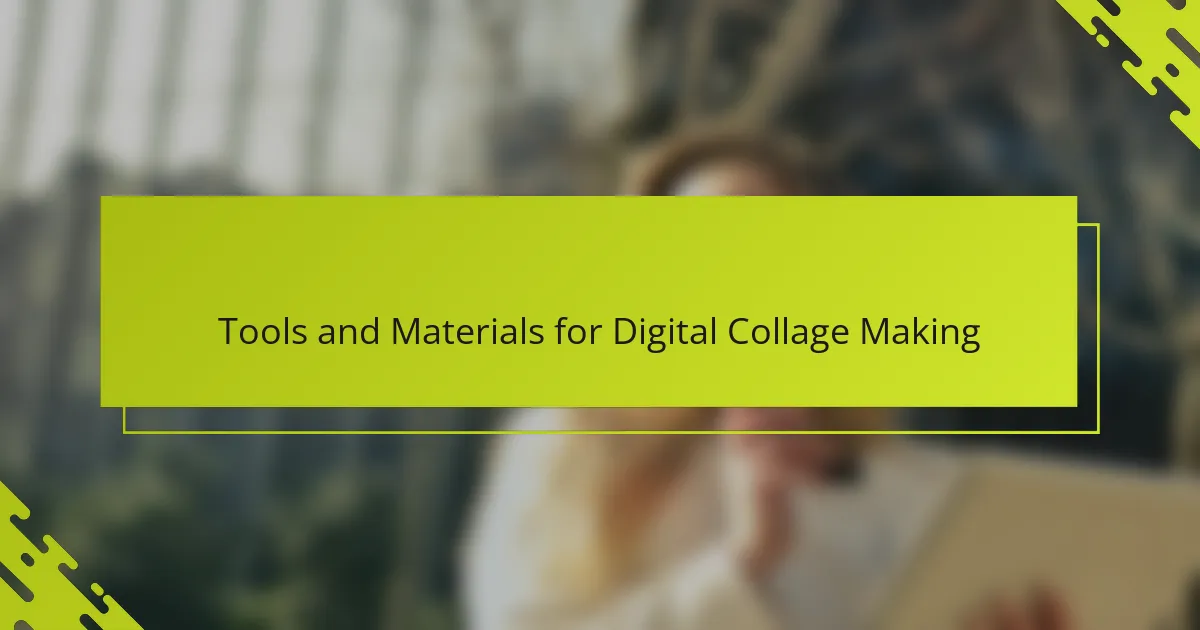
Tools and Materials for Digital Collage Making
When I first dove into digital collage making, the array of tools felt overwhelming—Photoshop, Procreate, Canva, and more. What I realized quickly was that the best tool is the one that feels intuitive, the one that lets your ideas flow without technical barriers. For me, experimenting with layers and brushes in Photoshop opened up endless possibilities, like adding depth to the stories I wanted to tell.
I also found that my choice of materials—images, scanned textures, and even screenshots from social media—became an extension of my voice. Have you ever noticed how the source of your collage elements influences the mood and message? Using queer zine art and vintage photos not only anchored my work in community history but made each piece feel like a personal and political statement.
Sometimes, I keep it simple: a tablet, stylus, and a trusty software program. Other times, I mix in analog elements, scanning handwritten notes or fabric patterns to blend the tactile with the digital. This blend feels right, as if bridging the gap between the virtual world and real-life experiences we navigate every day. Have you tried combining materials like this? It’s where the magic really happens for me.
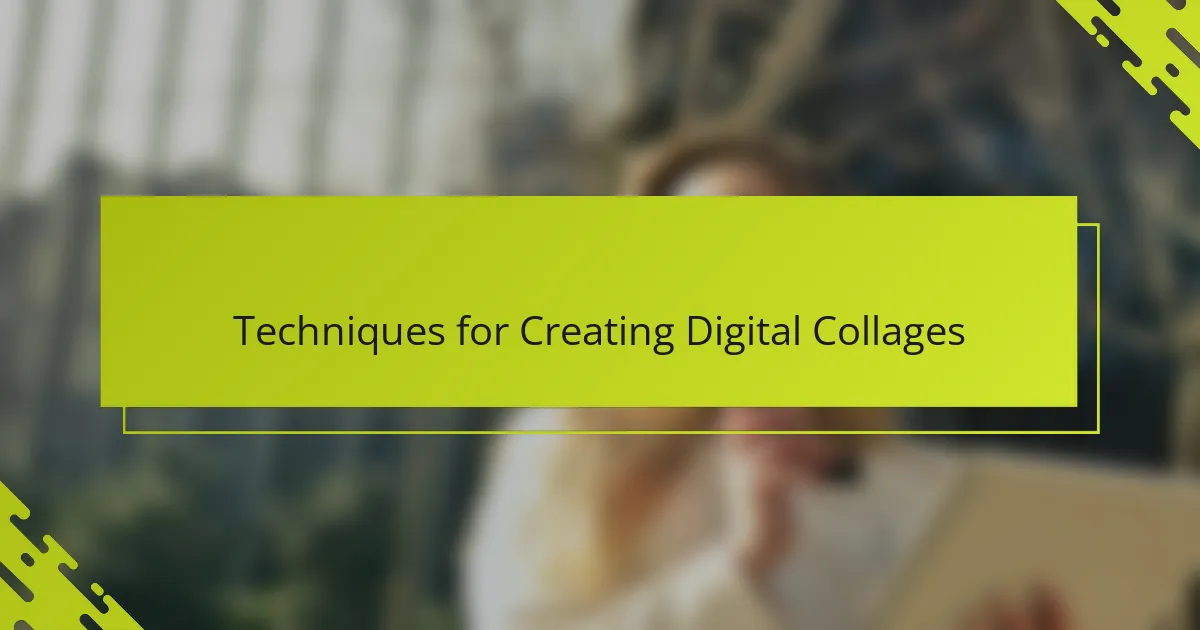
Techniques for Creating Digital Collages
One technique I swear by is layering. It’s amazing how stacking images with varying opacities can create a sense of depth and complexity, much like the layers of identity we often explore. Have you ever played with adjusting blend modes? Sometimes a simple change from “multiply” to “screen” completely shifts the mood, revealing hidden connections between elements.
Cutting and cropping digital images became my way of reshaping narratives. I love isolating fragments—an eye here, a hand there—to create new meanings from familiar visuals. It feels like reclaiming and remixing pieces of culture, making space for voices that are often overlooked. Do you find that cutting images digitally allows more freedom than traditional scissors and glue?
Lastly, I often manipulate textures and colors to evoke emotion. Filters, gradients, and subtle glitches add an imperfect, human touch that speaks to the messy, beautiful realities of queer life. There’s something powerful about intentionally breaking the digital “cleanliness” to reflect imperfection and resilience. Have you tried introducing digital imperfections? It transformed how I see my collages—not just as art, but as living stories.
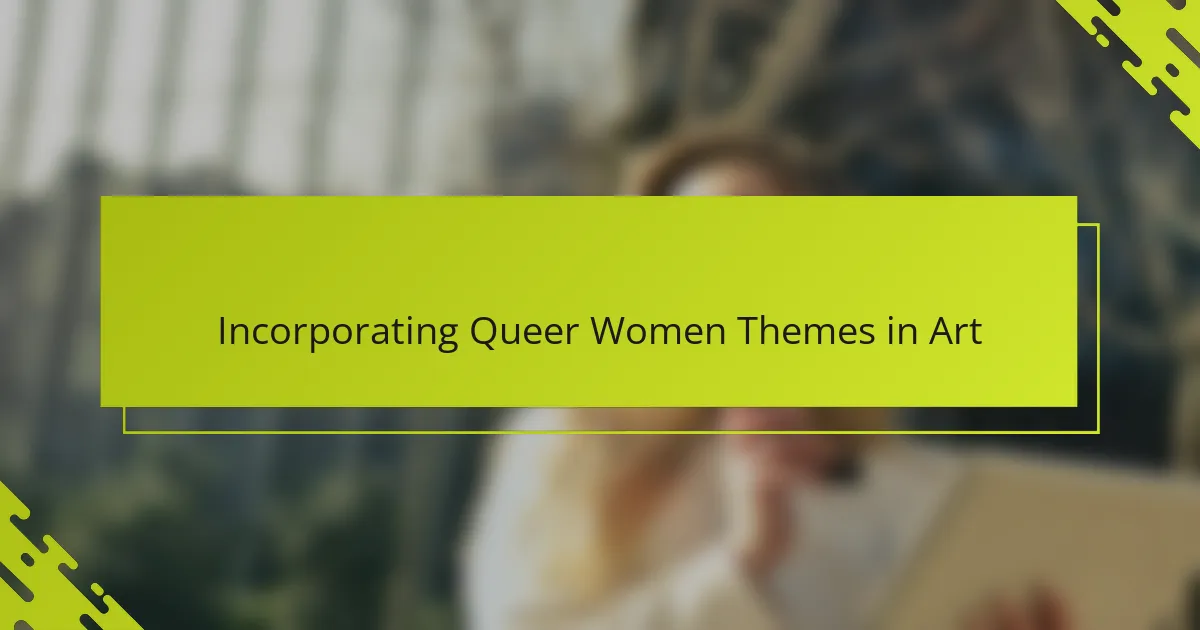
Incorporating Queer Women Themes in Art
Incorporating queer women themes in my digital collages always feels like a deeply personal act of storytelling. I find myself drawn to symbols and imagery that echo our shared experiences—whether it’s reclaiming vintage queer iconography or layering fragments of handwritten letters from friends. Don’t you think there’s something deeply healing about seeing these pieces come together visually, as if weaving individual stories into a collective tapestry?
I often ask myself how to balance visibility with nuance, capturing the diversity within queer women culture without flattening it. It’s a delicate dance, one that makes me slow down and listen more closely to the voices in my community. For example, including subtle nods to intersectionality—such as blending colors and textures that reflect different cultural backgrounds—adds layers of meaning I want viewers to discover over time.
Sometimes, I use contrast and fragmentation intentionally to highlight the tensions and resilience in queer women’s lives. A torn photograph layered over a digital glitch can speak volumes about disruption and survival. Have you noticed how those visual breaks make the emotional narrative more vivid? For me, these imperfections aren’t flaws; they’re truths that give the collage authenticity and heart.
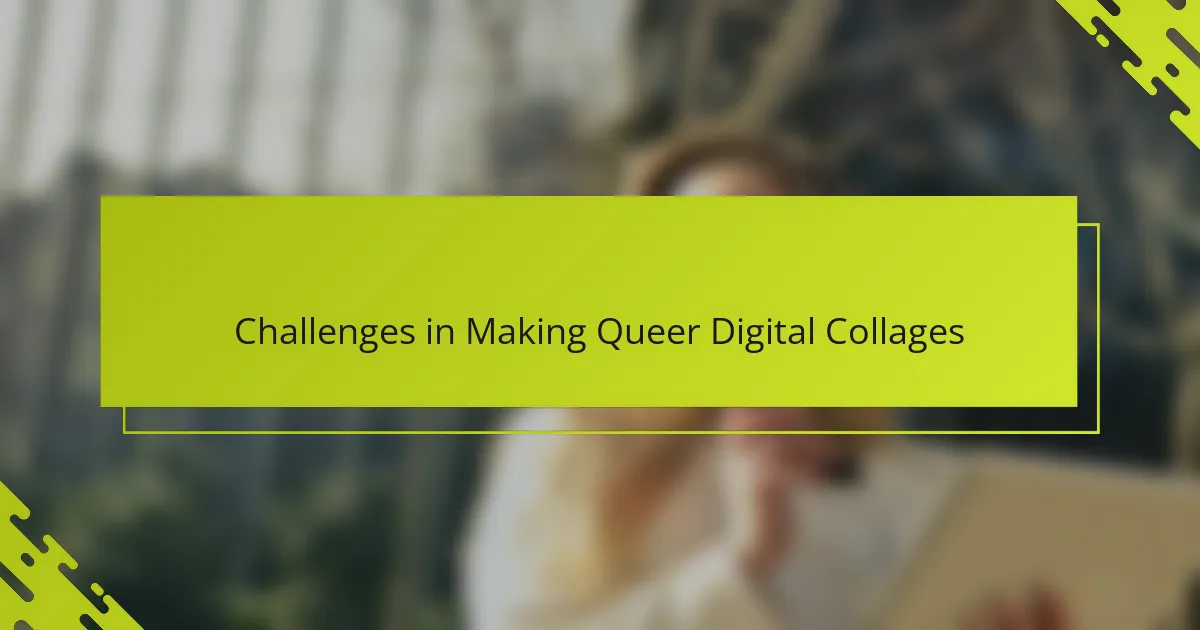
Challenges in Making Queer Digital Collages
One challenge I often face is finding imagery that truly represents the diversity within queer women culture without resorting to stereotypes. Have you ever struggled to find visuals that feel authentic rather than clichéd? I sometimes spend hours searching or editing elements just to avoid flattening the rich complexity of identities into familiar tropes.
Another hurdle is balancing visibility with subtlety. How do you make your message clear without overwhelming the viewer? I’ve learned that layering too many symbols or text fragments can muddy the emotional impact instead of enhancing it, so choosing what to reveal and what to hint at becomes a delicate, almost intuitive process.
Technical glitches have also taught me patience. Early on, I lost hours of work because of software crashes or file corruption—and that frustration made me appreciate how vulnerable digital art creation can be. Yet, these setbacks sometimes pushed me toward new creative directions I wouldn’t have discovered otherwise. Have you noticed how imperfection in process often sparks unexpected inspiration?

Sharing and Exhibiting Digital Collages
Sharing my digital collages online always feels like sending a piece of my inner world out into the vast, sometimes chaotic, digital space. I remember the first time I posted a collage on a queer art forum—it was nerve-wracking, wondering if anyone would connect with something so personal and layered. Have you ever hesitated before sharing your art, worried it might be misunderstood or overlooked?
Exhibiting digital collages in virtual galleries or zine collections has opened up amazing opportunities for visibility and dialogue. There’s something powerful about seeing my work alongside other queer women artists, all of us carving out space for stories that rarely get told. The immediacy of online sharing means feedback feels like a real-time conversation, which makes the experience feel that much more intimate and alive.
Yet, I’ve also learned that sharing isn’t just about exposure—it’s a form of activism. When I exhibit my collages, I’m not just showing art; I’m challenging norms and creating a visual language that celebrates queer resilience and complexity. Have you noticed how sharing your work can transform it from private expression into a collective experience? That shift is where the true magic happens for me.

Personal Reflections on Digital Collage Making
There’s something surprisingly intimate about digital collage making that I didn’t expect at first. As I piece together fragments—sometimes from my own life, sometimes from found images—it feels like I’m having a quiet conversation with myself, one that helps me understand layers of my identity I hadn’t fully seen before. Have you ever experienced art serving as a mirror and a window at the same time?
At times, I get frustrated when a collage doesn’t come together the way I imagined. But then, those moments of “failure” often lead me to unexpected discoveries—a color shift, a new texture, or an accidental overlay—that breathe fresh meaning into the work. It’s taught me that digital collage isn’t just about control; it’s about surrendering to the process and letting the art evolve organically.
Reflecting on this journey, I realize digital collaging has become more than a creative outlet; it’s a form of emotional release and healing. Each piece feels like a small rebellion against invisibility, a way to claim space for stories that aren’t always seen or heard. Do you find that making art in this way helps you hold your own truths a bit more gently? For me, that’s been one of its deepest gifts.
